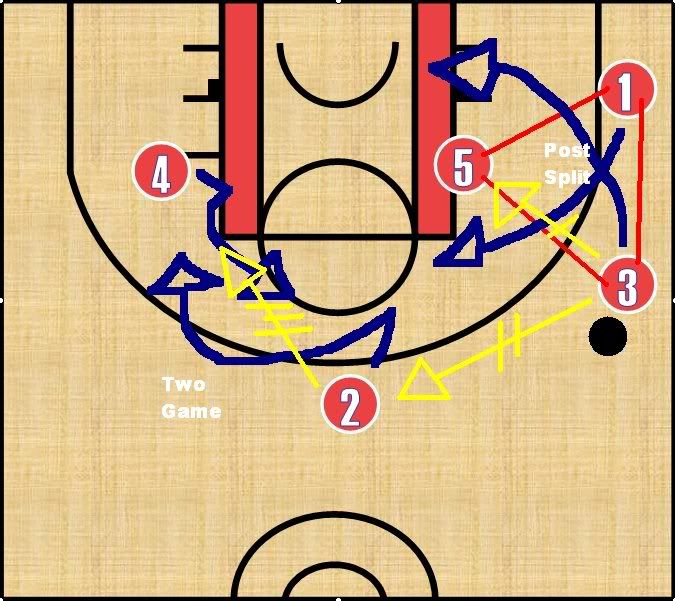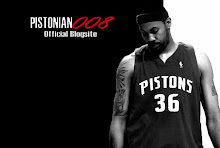
The Triangle Offense, also known as the Triple-Post offense, is an offensive strategy in basketball. Its basic ideas were initially established by Hall of Fame coach Sam Barry at the University of Southern California, and his system was later refined by former Kansas State University head basketball coach and former Los Angeles Lakers consultant Tex Winter, who played for Barry in the late 1940s.
The system's most important feature is the sideline triangle created between the center, who stands at the low post; the forward, at the wing, and the guard at the corner. The team's other guard stands at the top of the key and the weak-side forward is on the weak-side high post — together forming the "two-man game".
The goal of the offense is to fill those five spots, which creates good spacing between players and allows each one to pass to four teammates. Every pass and cut has a purpose and everything is dictated by the defense.
Technique
The offense starts when the ballhandler passes to the wing and cuts to the strong-side corner. The triangle is created from a post player on the strong-side block, the strong-side corner, and the extended strong-side wing, who gains possession on the first pass. The desired initial option in the offense is to pass to the strong-side post player on the block in good scoring position. From there the player has the options of looking to score or pass to one of the perimeter players whom are exchanging from strong-side corner and wing, a dive cut down the lane, or the opposite wing flashing to the top of the key which initiates another common option known as the "pinch post".
If a pass to the block is not possible, the second option is either to pass to the weak-side guard who flashes top of the key from the weak-side wing position or passing to the strong-side corner. If the ball is passed to the corner the options are either shoot, pass to the strong-side block, or pick and pop with the wing. If it is passed to the weak-side guard it initiates the "pinch post" option. There are two options. The first and most common is to pass to the weak-side forward who flashes to the elbow (corner of the key at the free throw line) to receive the pass. When he does the options are a rub handoff, back door cut by guard without the ball, post up of the guard on a smaller player, or face up and attack. The second option is a pick and roll with the forward. The advantage to the first option is there are so many weapons to attack the defense it opens up a lot of freedom and ability to score effectively. The advantage on the second option is that the player who has the ball and uses the screen now has the entire side of the floor to work with to go one on one. Meanwhile, on the other side, the wing sets a screen for the corner guard on the triangle split. If the hand-off is not available, the forward or the guard can pass to the corner guard coming off the screen. If the defense overplays or expects the split, both the wing and the corner guard can back cut to the basket. During all of this time the original strong-side block player is able to establish position for an easy shot while the defender is lured by all of the movement and cutting by the other players.
If the strong-side wing-to-guard pass is not possible, the third option is for the weak-side forward to flash to the strong-side elbow, take the pass, and cut to the basket on the trademark backdoor play of the offense. Meanwhile, the wing and corner guard exchange on a down screen. The forward with the ball can pass to the cutting guard or to the corner guard coming off the wing's screen. If nothing's available, he can shoot the basketball himself.
The offense also has a variety of options if there's heavy pressure from the defense. If the initial wing-pass by the guard isn't available, the triangle can be created on the other side by passing to the other guard, who then passes to the weak-side forward (who then becomes the strong-side wing). The guard, who initially had the ball, then cuts to the other corner. The center or the pressured wing can flash to the opposite post. If the guard-to-guard pass is not available, the weak-side forward can make a similar flash cut that was mentioned earlier. That also creates many cutting opportunities. If there is heavy pressure on everybody, the center can release the pressure by cutting to the high post for a pass by the ballhandling guard. That would also create space for possible cuts.
Criticisms
Most critics of the triangle offense cite its high level of difficulty and longer-than-average learning process.
Proponents argue that, when learned, the triangle becomes very natural and is structured so as to make sense. The guiding philosophy behind the offense is to pursue the path of least resistance.
Triangle Offense in the NBA
Head coach Phil Jackson, with help from assistant coach Tex Winter, has utilized the triangle offense to great success. The Chicago Bulls under Jackson won six NBA titles in the 1990s playing in the triangle. Jackson's Los Angeles Lakers later won three championships employing the triangle.
NBA greats Michael Jordan, Scottie Pippen, Shaquille O'Neal, and Kobe Bryant never won NBA championship titles before their teams adopted the triangle system (Shaquille O'Neal later won an NBA championship without the triangle offense in 2006 as captain of the Miami Heat). Other teams, such as the New Jersey Nets and Indiana Pacers, have adopted certain elements of the offense, but in NBA history, only teams coached by Phil Jackson have used the arsenal of the offense in its entirety.
Presumably this means that the offense's inventor, Tex Winter, did not use his own offense when he was the head coach of the Houston Rockets.
In addition to 9 championships, Jackson has won over 1000 total games during his Hall of Fame career (regular season victories and playoff victories combined) as an NBA head coach, and has never failed to reach the NBA Playoffs during his time as coach of both the Bulls & Lakers. Tex Winter has worked for Jackson as an assistant for all of Jackson's NBA head coaching career.
Triangle Offense was cornered by the Utah Jazz Coach Jerry Sloan and Later, Greg Popovich of the San Antonio Spurs and Larry Brown of the Detroit Pistons
This Offense is still effective it depends on the coaching system. if the coach is better like phil, Greg or Larry







No comments:
Post a Comment